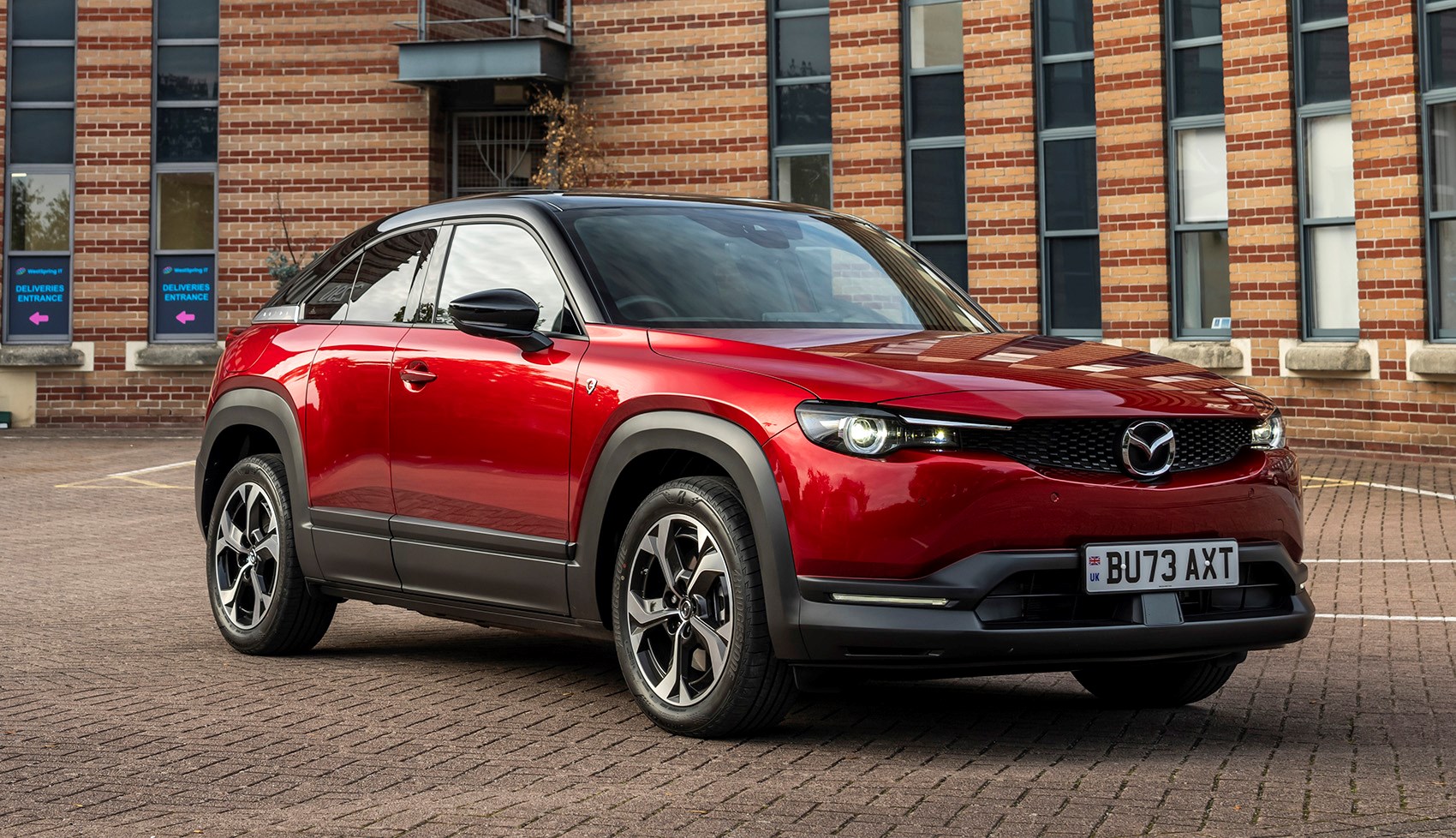► Range extender MX-30 R-EV driven in the UK
► Technically, it’s a plug-in hybrid too
► Does it work on the road?
We got quite excited when Mazda quietly confirmed that it was looking into how it could deploy its rotary engine technology in new cars. The engineering tech has always been something of a novelty as well as a Mazda speciality, finding itself in models like the Cosmo, as well as the well-liked and under-bought RX-8 as well as the iconic RX-7 among others.
In the age of electrification, though, it’s not quite as straighforward for Mazda to just use the technology again no matter how it’s ingrained in the company’s DNA. This is a carmaker that likes to go its own way, but alongside others, it needs to decarbonise.
So it needed to come up with a new way of using the technology in a way that’s compatible with this noble environmental aim. The trouble with old-school rotaries was that they were buzzy, high-revving and heavy on fuel. For 2024, it’s been reborn as a compact range extender that transforms the MX-30 EV into the far more usable MX-30 R-EV.
I thought the MX-30 was electric…
The MX-30 EV (which you can read about here) isn’t going anywhere. Despite its disappointing sales, it remains on the price lists. That means the R-EV variant runs alongside it in an idisyncratic two-pronged attack on the electrified market. Mazda hopes this will broaden the appeal of the MX-30.
This could be a smart move, mainly because the electric version of the MX-30 has one colossal flaw: range. It may look funky, come with a well-built interior and drive sweetly, but the EV model’s paltry electric range made it one of the least competitive EVs on sale in that regard. While official range claims are higher, our experiences have frequently resulted in one mile per battery percentage of charge (i.e. 100 miles on a charge), which just isn’t good enough.
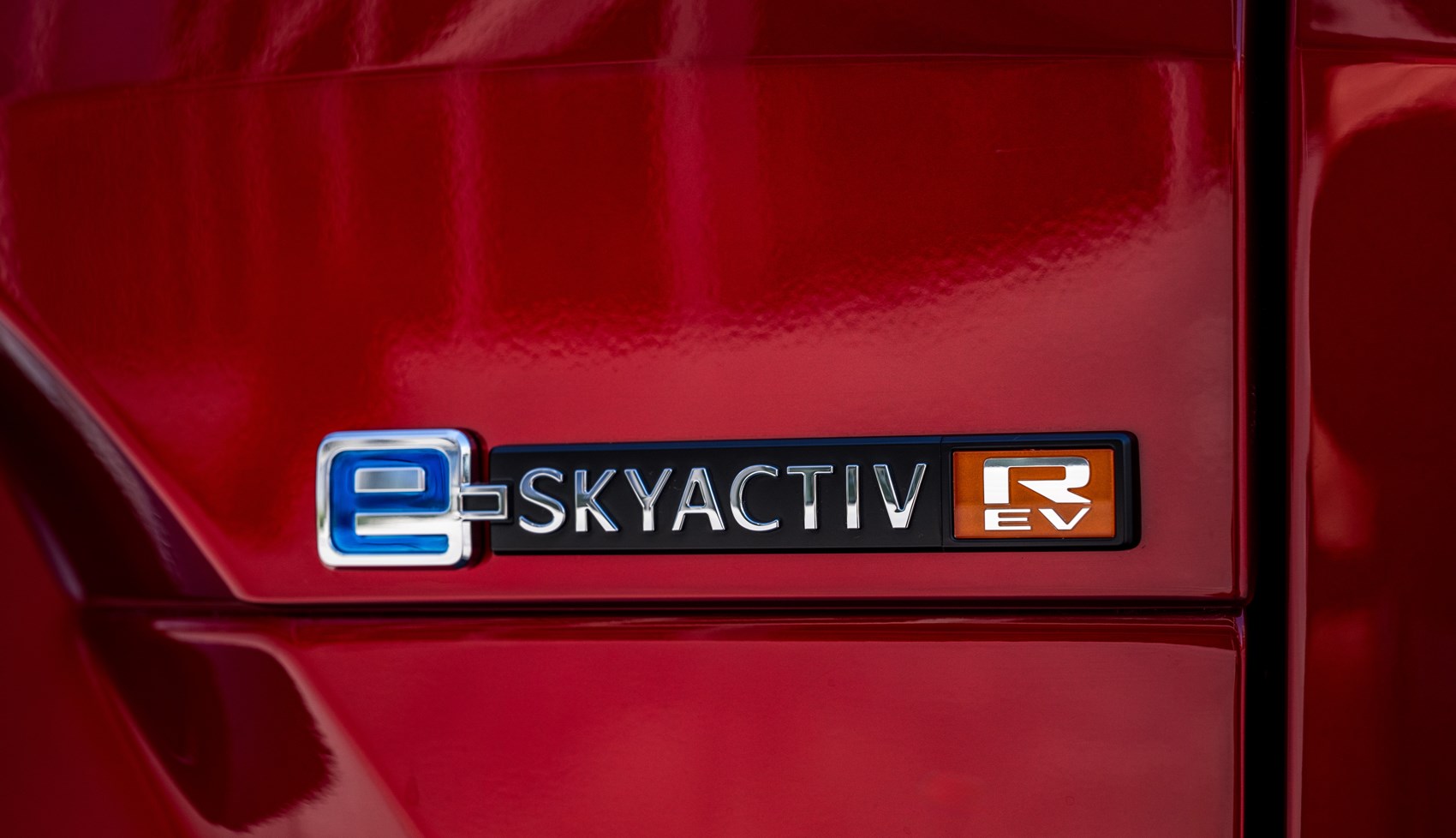
How does the rotary range extender work?
Instead of pistons sliding up and down within individual cylinders, a rounded-yet-triangular rotor spins inside a chamber. The rotary engine is famed for its smooth power delivery, small size and low weight – but can be thermodynamically inefficient compared to conventional engines and prone to higher oil consumption and more serious wear in a shorter timeframe.
Here, the new-generation 830cc rotary combustion engine features a single rotor with a 120mm radius and 76mm width. It develops 73bhp and works purely as a generator.
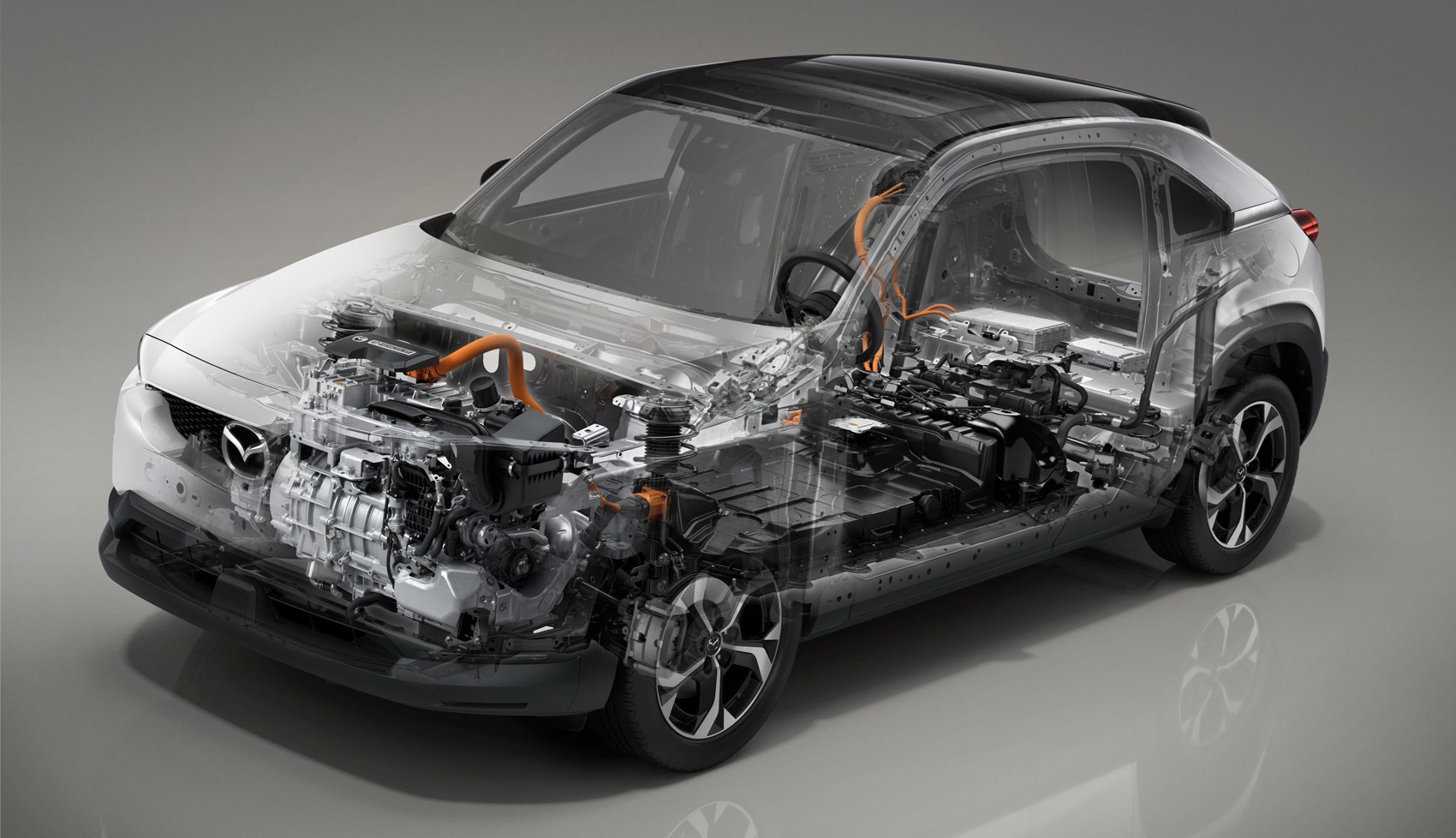
Mazda says it’s focused on improving the rotary’s weak points, with technical expert Yoshiaki Noguchi telling us: ‘so long as it’s being used normally with regular maintenance, oil consumption has been improved.’ Rotor tip wear has also been a point of focus, with Mazda saying it uses 2.5mm-wise apex seals (instead of 2mm ones in older rotary powertrains) and a friction-reducing plasma coating here.
That rotary powerplant works alongside a 17.8 kWh battery pack and a 167bhp electric motor. Given it’s a range extender, the rotary doesn’t drive the front wheels at all – instead only charging the battery pack. Also given the extra complication, the R-EV is around 150kg heavier than the electric model.
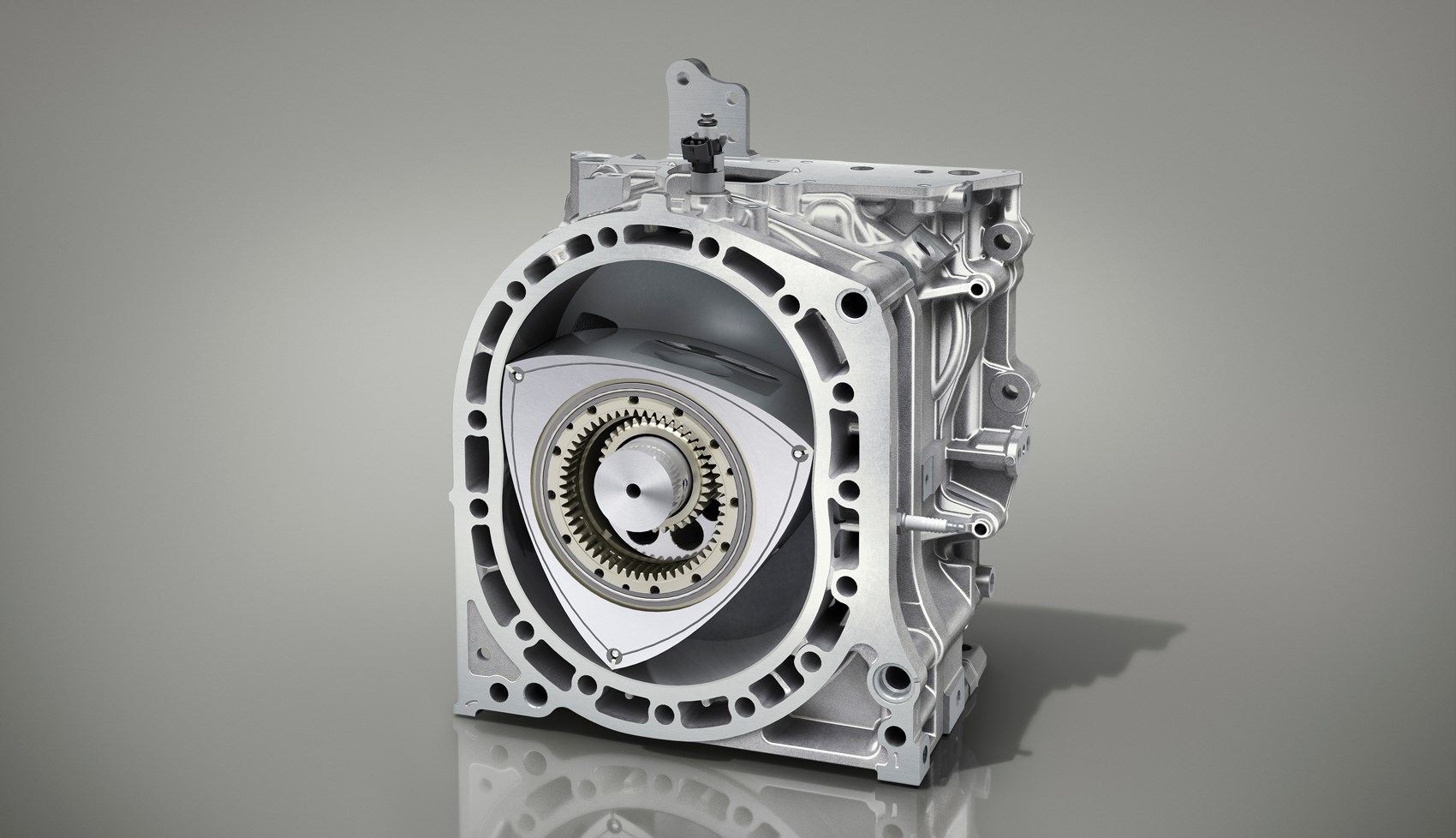
On a full battery charge, Mazda says the R-EV claims a range of 53 miles out of its dinky battery, which is even less than the MX-30 EV. But, obviously, the battery can be charged on the move using the rotary engine, maintaining and even increasing charge while you’re driving.
That state of charge is something you can maintain yourself with the three drive modes on the R-EV: Normal, EV and Charge. They’re all self-explanatory: when in Normal mode, the R-EV will aim to maintain around a 45 per cent battery charge to always make sure there’s enough punch available; EV mode forces the car to run on e-power only until the battery is completely depleted; Charge allows you to reserve a certain state of battery fullness to your requirements.
When the battery drops to your set point in Charge mode, drops to 45 per cent in Normal mode or depletes completely in EV mode, the rotary engine kicks in. If the battery drops to zero (and the range extender gets to work on keeping enough power to maintain propulsion), the top speed is limited to 81mph (instead of its top speed of 87mph).
The R-EV model can also be charged conventionally. For a 20-80% charge, Mazda quotes around 1h 30m on a 7.2kW point, around 50 mins on an 11kW point or around 25 mins on a 36kW DC charger.
What’s it like inside the MX-30 R-EV?
Pretty much the same as the MX-30 EV, which is no bad thing. While this is arguably one of Mazda’s more cluttered dashboard layouts (I still maintain the Mazda 3 has one of the most sensibly laid-out cockpits of any car on sale after living with one for a year), it’s still good.
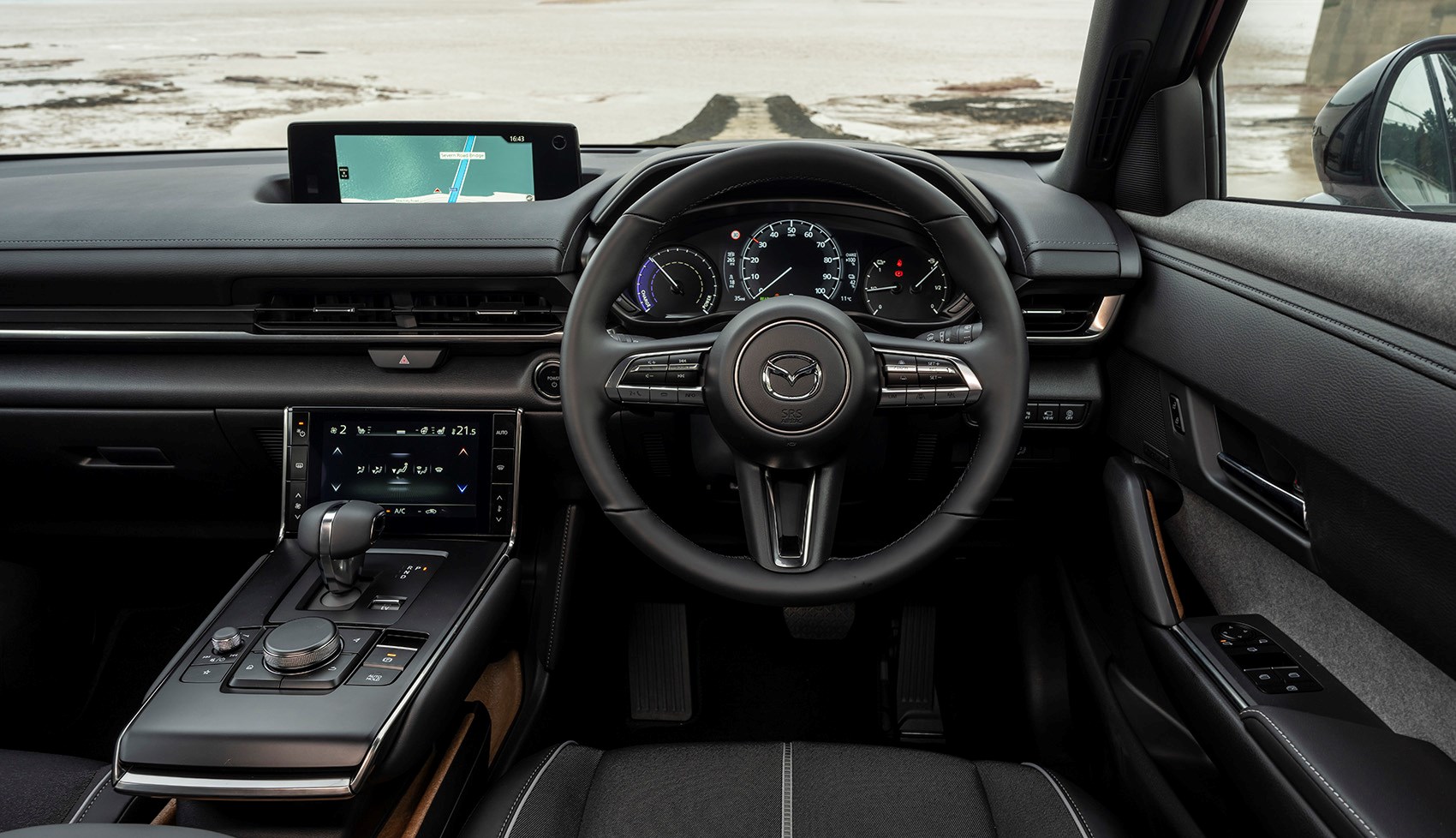
That infotainment display is clear enough to read and simple enough to operate, with easy-to-read (if plain) mapping and a functional layout. The R-EV model even comes with its own version of the energy flow monitor where you can see a little rotor icon under the bonnet that glows when the engine is active.
What’s less convincing, however, is the touch display low down on the dashboard. It’s placed for easy access, yes, but it just feels fiddly to operate – especially when a lot of the settings are cloned with physical switchgear running down the sides. Just including the bank of physical switchgear from the 3 hatchback or even the CX-60 SUV would have sufficed.
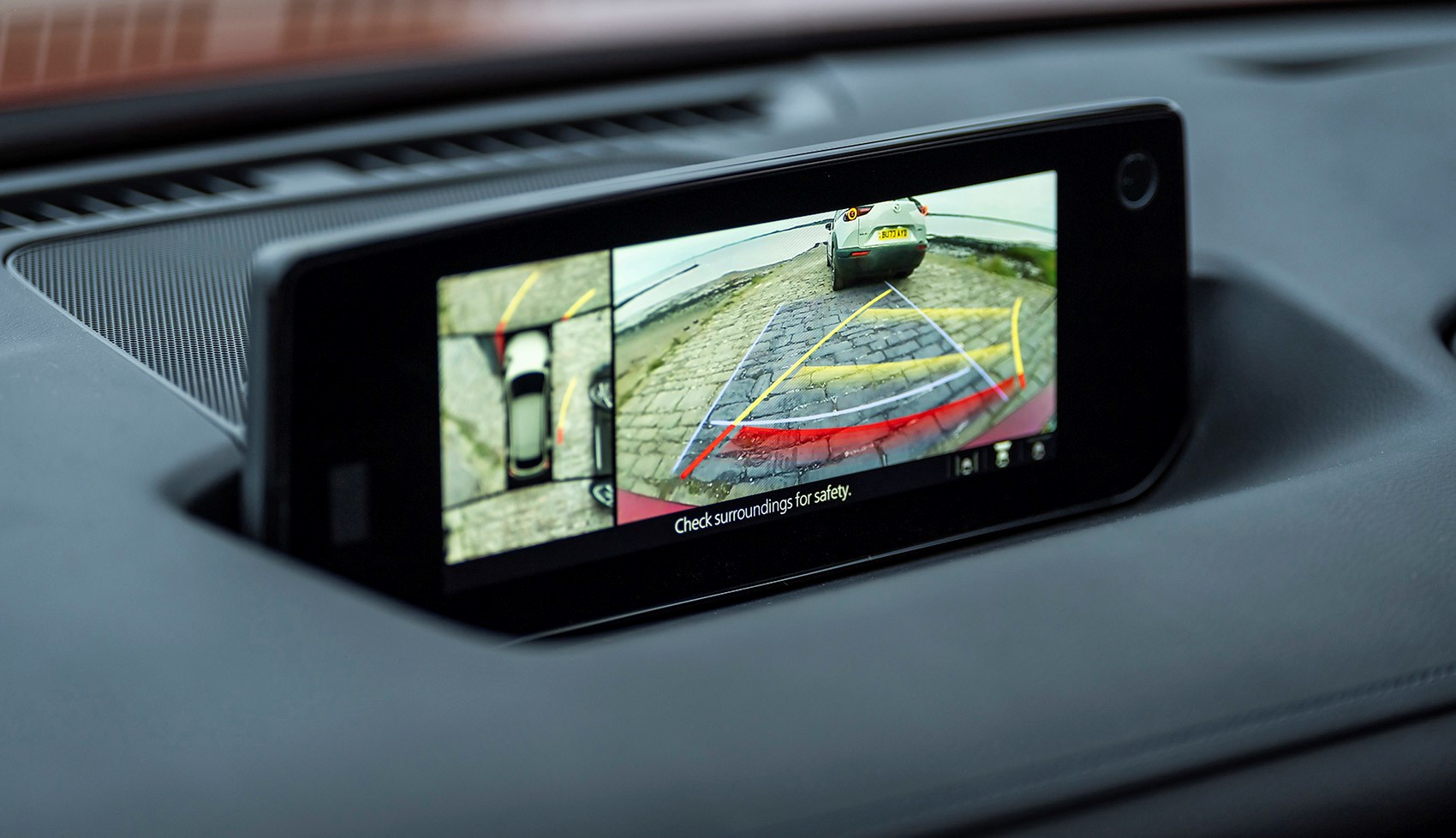
And then there are the weird rear doors. I know what Mazda’s trying to do here: instill a bit of sporty appeal by technically making the MX-30 look like a two-door, as well as nod back to the RX-8, but they’re just a faff to use day-to-day. Boot space also takes a slight hit – up to 350 litres with the rear seats up is 16 litres lower than the MX-30 EV.
How does that range extender powertrain work in the real world?
It’s a mixed bag. Outright performance is adequate, which is all you really need in this kind of car. Its nine-ish-second 0-62mph sprint is about on par with the likes of the Vauxhall Mokka Electric and about a second faster than the Nissan Juke Hybrid.
Power delivery is smooth and assured rather than punchy (just like the EV version, then) and Mazda’s clearly worked to finesse the throttle response through that sweet, floor-hinged pedal. The brakes, meanwhile, are a little more unpredictable. There’s about an inch-worth of travel that’s a little soggy and soft before the brakes really kick in the harder you push – it can take a little getting used to when you’re pottering around town as the sensation feels most obvious at slower speeds.
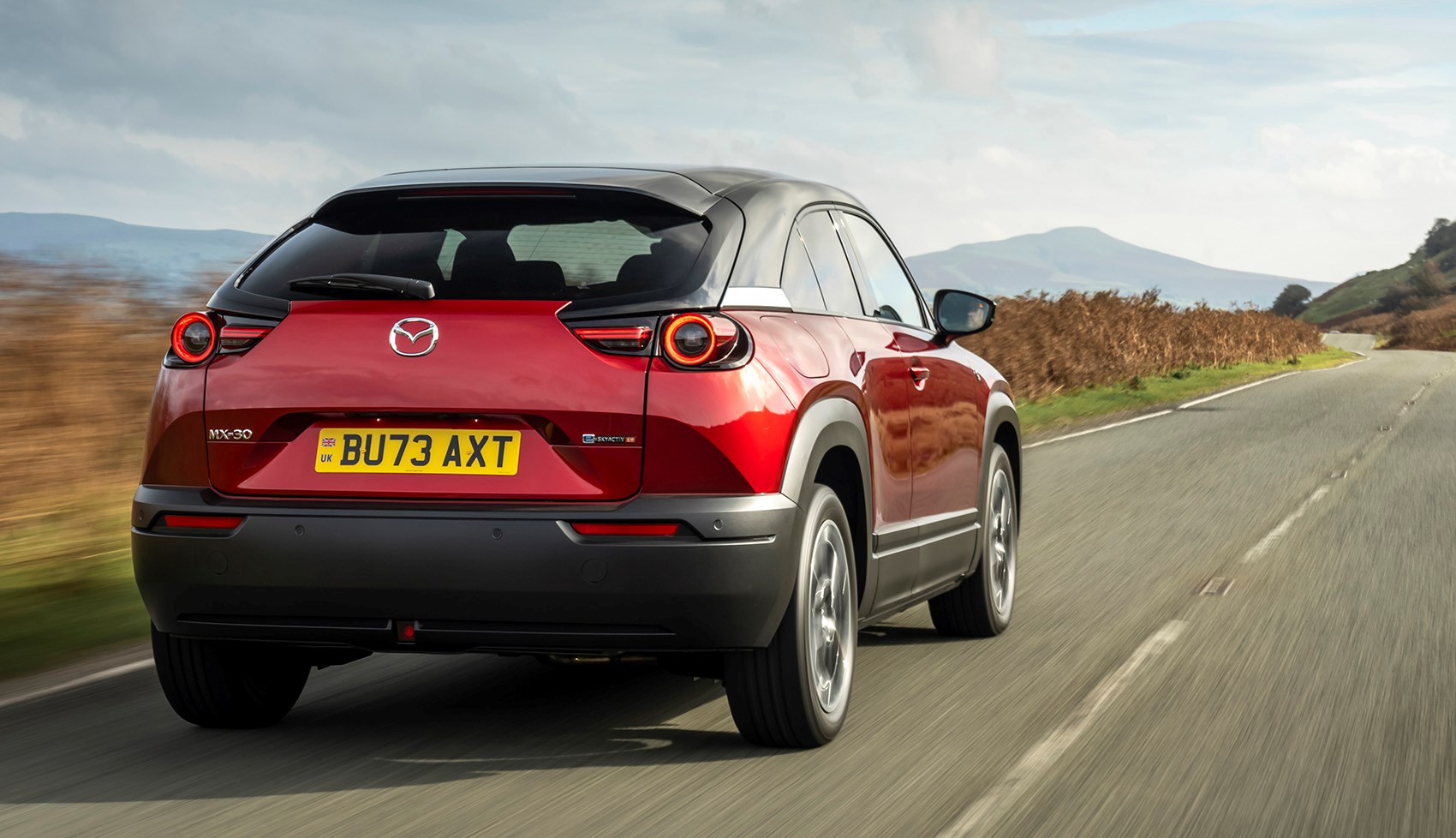
And then we come to the R-EV’s party piece – that rotary range extender. It sounds… odd. Not necessarily bad, per se, but just weird. The closest thing to compare it to would be like something in between a Toyota hybrid running a CVT gearbox and Renault’s E-Tech Hybrid powertrain, where certain speeds will wake the engine up and it may maintain a certain rpm, or those revs will build and drop with your throttle inputs depending on the mode you’re in.
The noise itself is certainly buzzy and fizzy, but it’s clear Mazda has tried to damp it as best it can – it sounds like you live in the house next door to a regular gym-goer blending their protein smoothie.
But its ability to maintain charge is impressive – even at high speeds – which allows you to relax a little about the battery going dead. It’s almost as if it’s that rotary’s mission to make sure that doesn’t happen.
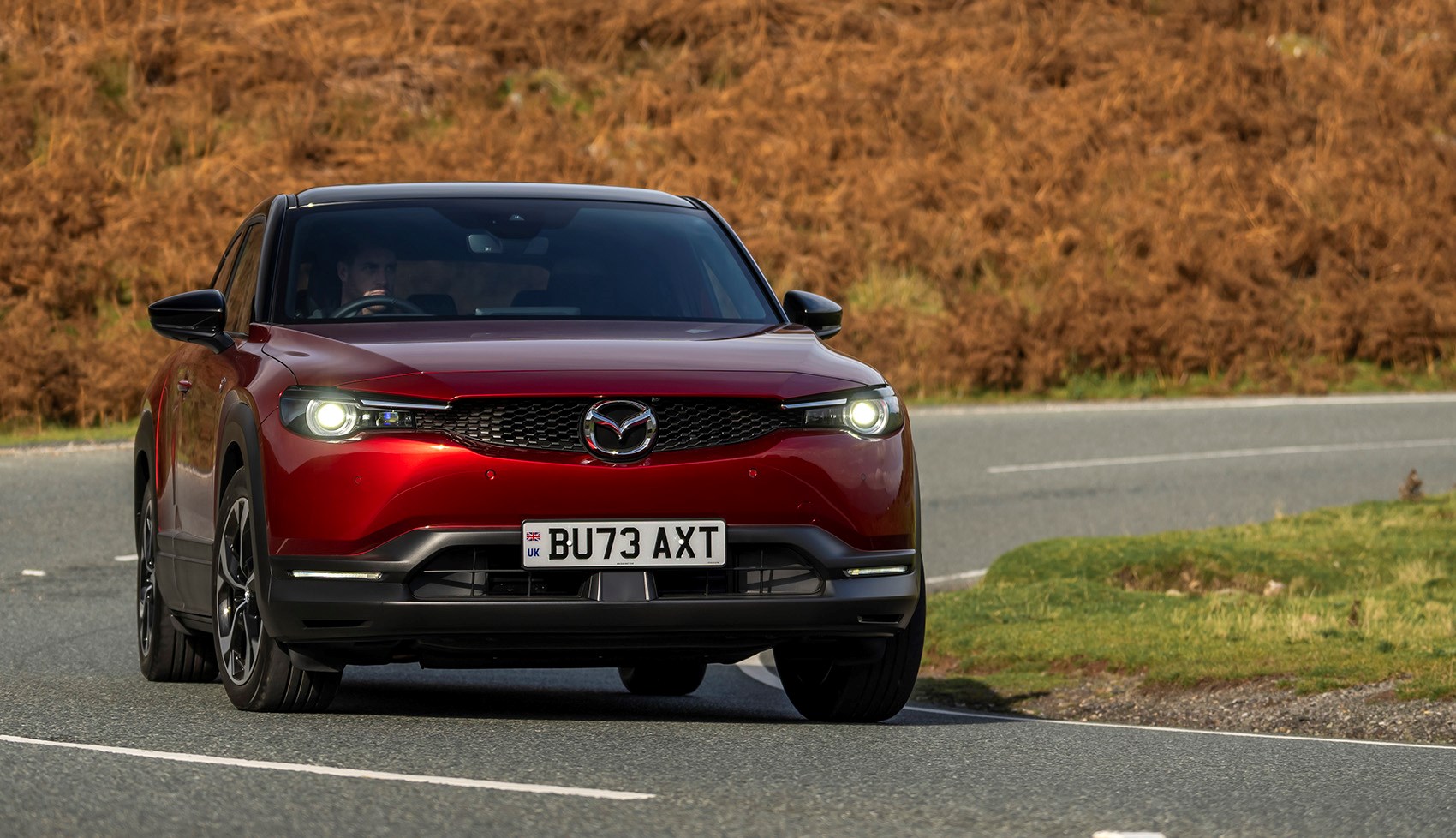
It’s a mixed bag when it comes to fuel economy, however. On a two-leg run in north Wales, we managed an easy 90mpg in hybrid mode. On clogged B-roads with the odd bit of opportunistic overtaking, this dropped to about 50mpg. On the return leg, we left it in charging mode with the buzzy rotary running almost constantly, and that dropped to 36mpg.
It’s best, then, to treat the MX-30 R-EV like a proper plug-in hybrid then – use the available e-range when you can, and rely on the rotary over long journeys or when you’re away from a plug for a longer period of time.
How does the new R-EV handle?
Overall, it’s obvious that Mazda has tried to sprinkle a little dynamism into its small electrified crossover in the same way it has done with a lot of its cars over the years. This is certainly one of the sweeter examples of the breed to drive.
Let’s start with the steering. There’s an alertness off-centre as you initially steer – a welcome trait, and one not often felt at this shape and size – and the steering itself feels progressive and smooth, too. The trade-off for that alertness is that it’s a bit nervous at lower speeds, where tiny adjustments in your inputs really do result in tiny trajectory changes. It calms down at higher speeds, and rewards drivers that relax behind the wheel.
The ride and body control is good, too. There’s a reasonable amount of body control with little roll felt on sweeping country roads. The ride, ditto, is a reasonable balance between firm and comfortable – the only thing that seemed to catch the suspension are high-frequency ripples at speed, which patter annoyingly.
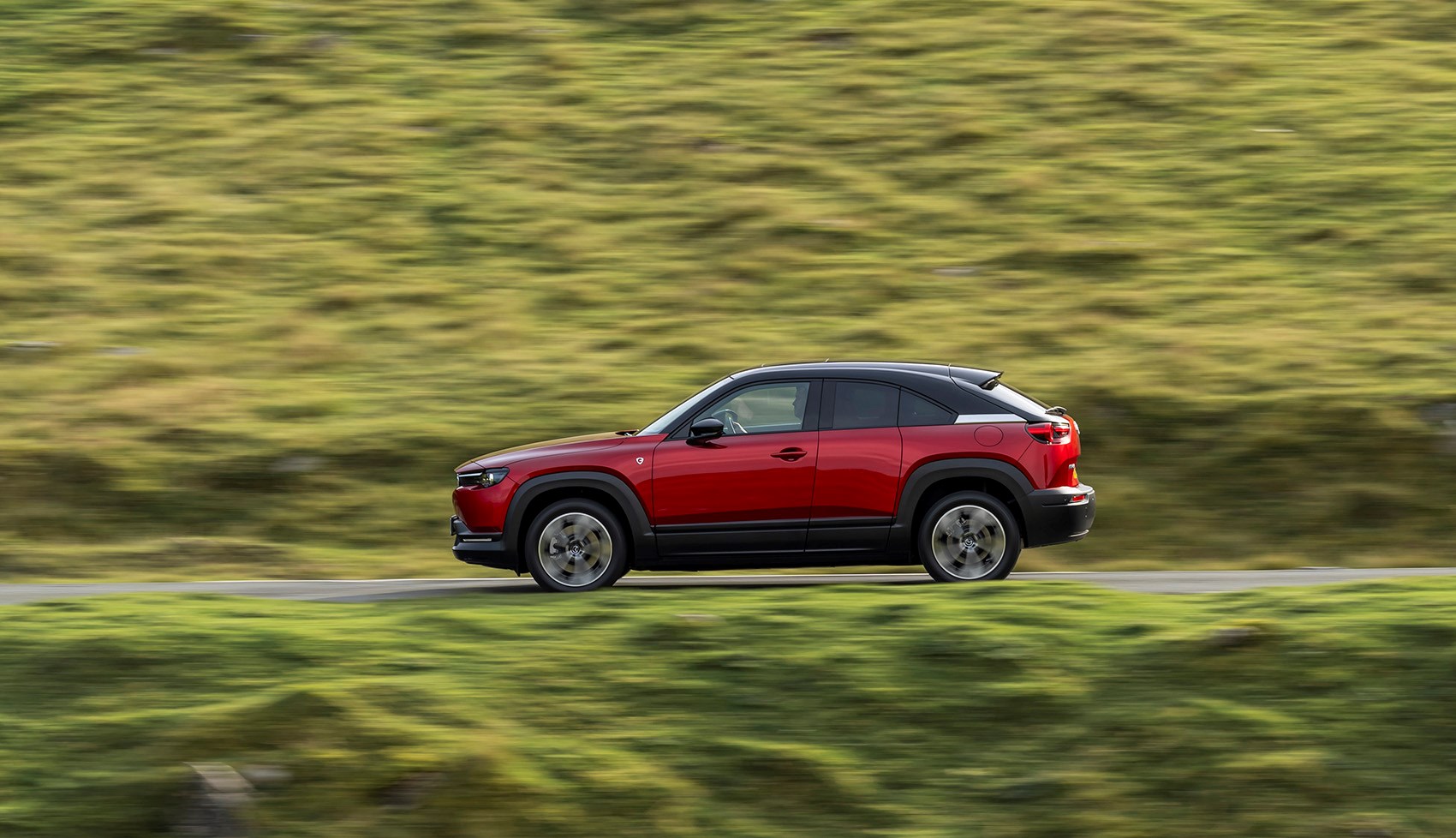
Anything else I should know?
The entry-level MX-30 Prime-Line R-EV’s price starts at the same point as the electric version: £31,250. That’s a lot of interesting plug-in hybrid for not a lot of money – especially in the same world that plays host to the £40k Vauxhall Astra.
Other versions are badged Exclusive-Line and Makoto, which packs in 360-degree camera, adaptive LED headlights, a large tilt/slide glass sunroof and a full suite of driver assistance systems and an effective adaptive cruise control system. That’ll cost you £35,550.
On top of that, Mazda celebrates the return of the rotary with a limited edition R-EV: the Edition R. As well as all of the trimmings and bespoke wheels, the R-EV features bespoke black body/red roof paintwork and the headrests are embossed with a rotary symbol. If you want one, tough: the UK’s allocation is already sold out.
Mazda MX-30 R-EV range extender: verdict
The electric model’s poor range meant it was only appealing to a very limited group of buyers. Adding a rotary combustion engine to the mix, it seems, has unlocked the potential of the MX-30 as a small and fashionable runabout.
It’s hugely amusing and interesting to know how much attention and effort Mazda has put into making rotary work in new surroundings and it’s managed to inject another quirk into an already idiosyncratic small family car.
Even so, we think Mazda’s managed to pull it off. That is with the proviso, however, that users treat the R-EV like a plug-in hybrid – it works best when the e-range is maximised and it’s hooked up to a power supply whenever possible. Don’t plug it in, and you’ll be staring down the barrel of less than 40mpg average…
